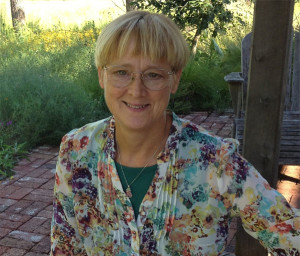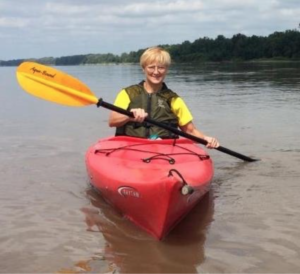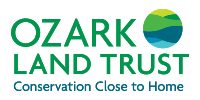By Peggy Horner

Working for Ozark Land Trust was the pinnacle of my conservation career. As I child, I knew from my early reckoning that I wanted to be a wildlife biologist. I succeeded in achieving that dream first as a researcher tracking black bears in the mountains of North Carolina, then focusing on endangered species with Texas Parks and Wildlife for eight years, then the Missouri Department of Conservation for 13 years. It was at MDC that I had the revelation that to protect endangered species – and all wildlife, including their habitats – it was the land that needed to be protected.
MDC does a great job conserving public land for public use, but I wanted to help permanently protect private land. I gradually shifted my focus to developing partnerships with organizations that conserved private land and helped secure funds that would protect endangered species and the land upon which they depend.
The natural progression for me was to work for a land trust. I was so thrilled to shift my career when I was hired at OLT as the Stewardship Director in April 2013. However, it was a short stint as I became the Executive Director three months later. I had a steep learning curve going from state agency biologist to a land trust director, but I loved the challenge. I brought all the state, federal and other nonprofit partnerships I had built while working at MDC. I knew that OLT needed to be a stronger partner at the table when ecosystem-wide decisions were made. We had a unique niche to fill – permanently protecting private land, and I knew how to apply for state and federal grants.
OLT was established as a solid organization under the leadership of two former executive directors, Gregg Galbraith (one of the founders of Ozark Regional Land Trust in 1987) and Ted Heisel. However, we lacked the national stamp of approval as an accredited land trust. To build stronger partnerships and prove our solid foundation, the OLT staff, board, and I began the rigorous process of achieving this and became the first land trust based in Missouri to be accredited by the Land Trust Accreditation Commission in 2019. And yes, our partnerships became more robust as we were recognized as being the leader in using conservation easements on private land as a means of permanent protection. Accreditation must be reviewed and re-evaluated every five years, and OLT just completed this review.
OLT also became a leader in working with other nonprofit land conservation organizations. I helped initiate the Missouri Land Trust Coalition at MDC, but it became a more extensive organization when I could focus on the Coalition as the OLT Executive Director. Since it was the region’s only coalition of land trusts, it included land trusts from several surrounding states. We held workshops for both private landowners and government officials on the use of conservation easements to protect private land, as well as training and information sharing among the staff of the land trust members.

Peggy Horner – Executive Director On the Missouri River
When I started at OLT, we had a very good but lean staff of three conserving and stewarding properties across the Ozarks in Missouri and Arkansas — the Huzzah Watershed Director, a Director and the Executive Director. We needed help to continue our mission, and two positions were added – a Conservation Director who would focus exclusively on land transactions and an Office Manager to handle details that would relieve the Executive Director to focus on the partnerships, accreditation and advancement. We were still lean but became even more efficient and effective. By the time I left, OLT had about 29,000 acres of land under its stewardship through conservation easements and ownership.
After achieving accreditation, it was a good time to refocus my energies on helping my aging parents during their final years in Maine, so I retired early. When I look back on my tenure at OLT, I have immense gratitude and remember the many private landowners, supporting members, staff and board members who helped make OLT a leader in private land conservation in the Ozarks. I was blessed to have been part of its strong conservation history, and know that going forward, OLT will continue to adapt to climate change and land conservation challenges and will lead the way in partnerships with private landowners, government agencies and other conservation organizations.
